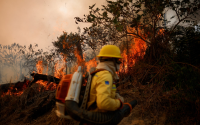23 July 2007Common Dreams
A study has yielded the first confirmation that global warming is already affecting world’s rainfall patterns, bringing more precipitation to northern Europe, Canada and northern Russia but less to swathes of sub-Saharan Africa, southern India and Southeast Asia.
 The changes “may have already had significant effects on ecosystems, agriculture and human regions that are sensitive to changes in precipitation, such as the Sahel,” warns the paper, released on Monday by Nature, the British science journal.
The changes “may have already had significant effects on ecosystems, agriculture and human regions that are sensitive to changes in precipitation, such as the Sahel,” warns the paper, released on Monday by Nature, the British science journal.
Scientists have long said that global warming is bound to interfere with snow and rainfall patterns, because air and sea temperatures and sea-level atmospheric pressure — the underlying forces behind these patterns — are already changing.
But, until now, evidence for declaring that the interference is already happening existed anecdotally or in computer models, rather than from observation.
One problem for researchers has been a lack of accurate, long-term rainfall data from around the world that would enable them to distinguish between regional or cyclical shifts in rainfall.
Francis Zwiers, a scientists with Environment Canada, Toronto, found a way around these problems by using two data-sets of global rainfall pattern beginning, conservatively, in 1925 and ending in 1999.
They compared these figures with 14 powerful computer models that simulate the world’s climate system, and found a remarkably close fit.
Over the 75-year period under study, global warming “contributed significantly” to increases in precipitation in the Northern Hemisphere’s mid-latitudes, a region between 40 and 70 degrees north, they say.
In contrast, the Northern Hemisphere’s tropics and subtropics, a region spanning from the equator to 30 degrees latitude north became drier.
And the Southern Hemisphere’s tropics (equator to 30 degrees latitude south) became wetter.
The study looked at annual average rainfall on the land, not at sea. In addition, it did not look at extreme weather events — episodes of drought and flooding — whose frequency and severity are also seen as likely to increase as a result of global warming.
The investigation is published by Nature on Thursday.
Previous work in the past few years has highlighted the loss of alpine glaciers and snow cover and the retreat of Arctic permafrost.
These were interpreted by the UN’s Intergovernmental Panel on Climate Change (IPCC), in a landmark report published this year, as confirmation that global warming has already started to affect parts of the climate system.






